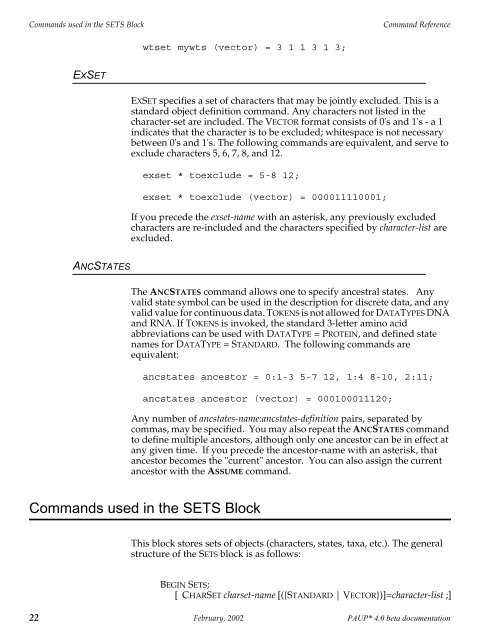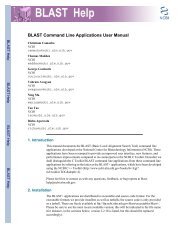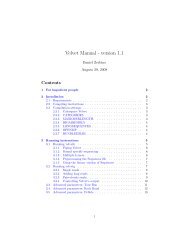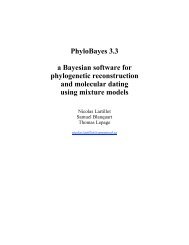PAUP* 4.0 Beta: Command Reference --Draft Version 3--
PAUP* 4.0 Beta: Command Reference --Draft Version 3--
PAUP* 4.0 Beta: Command Reference --Draft Version 3--
You also want an ePaper? Increase the reach of your titles
YUMPU automatically turns print PDFs into web optimized ePapers that Google loves.
<strong>Command</strong>s used in the SETS Block<strong>Command</strong> <strong>Reference</strong>wtset mywts (vector) = 3 1 1 3 1 3;EXSETEXSET specifies a set of characters that may be jointly excluded. This is astandard object definition command. Any characters not listed in thecharacter-set are included. The VECTOR format consists of 0's and 1's - a 1indicates that the character is to be excluded; whitespace is not necessarybetween 0's and 1's. The following commands are equivalent, and serve toexclude characters 5, 6, 7, 8, and 12.exset * toexclude = 5-8 12;exset * toexclude (vector) = 000011110001;If you precede the exset-name with an asterisk, any previously excludedcharacters are re-included and the characters specified by character-list areexcluded.ANCSTATESThe ANCSTATES command allows one to specify ancestral states. Anyvalid state symbol can be used in the description for discrete data, and anyvalid value for continuous data. TOKENS is not allowed for DATATYPES DNAand RNA. If TOKENS is invoked, the standard 3-letter amino acidabbreviations can be used with DATATYPE = PROTEIN, and defined statenames for DATATYPE = STANDARD. The following commands areequivalent:ancstates ancestor = 0:1-3 5-7 12, 1:4 8-10, 2:11;ancstates ancestor (vector) = 000100011120;Any number of ancstates-name:ancstates-definition pairs, separated bycommas, may be specified. You may also repeat the ANCSTATES commandto define multiple ancestors, although only one ancestor can be in effect atany given time. If you precede the ancestor-name with an asterisk, thatancestor becomes the "current" ancestor. You can also assign the currentancestor with the ASSUME command.<strong>Command</strong>s used in the SETS BlockThis block stores sets of objects (characters, states, taxa, etc.). The generalstructure of the SETS block is as follows:BEGIN SETS;[ CHARSET charset-name [({STANDARD | VECTOR})]=character-list ;]22 February, 2002 <strong>PAUP*</strong> <strong>4.0</strong> beta documentation





